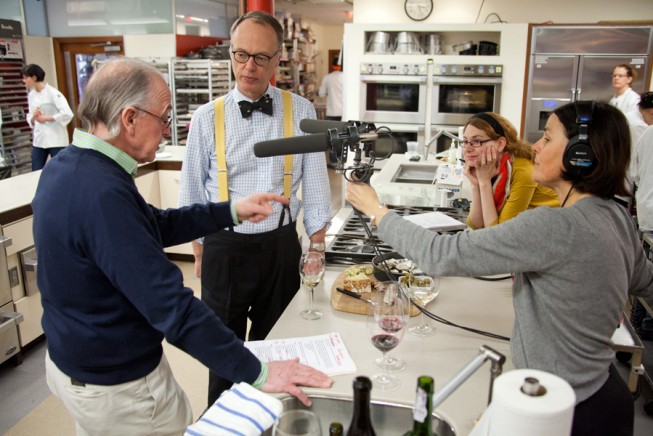
It’s not easy to translate sensation into words, but sommeliers, retailers, and even winemakers are under constant pressure to do it. Much of the rhetoric that ensues is fanciful and frankly useless, but a handful of terms now seem to have entered what might be called wine’s universal, if unofficial, lexicon—a set of terms most experienced wine tasters can agree on and find both meaningful and useful. Among these are three now commonly used descriptors: minerally, herbaceous, and vegetal.
These terms are useful because they make a connection with things that everyone is familiar with and so provide (or should) for the possibility of a common non-specialist vocabulary for talking about wine.
Although one of them, minerality, is perhaps a bit of a stretch on this point. We don’t routinely eat stones or soil. It’s easier, or should be, to recognize something that expresses herbaceousness or a flavor that’s reminiscent of a vegetable, since our diet presents these sensations to us pretty much every day.
To test the theory, I first scoured the wine tasting database I’ve been keeping for 20 years for recent notes that included the words mineral, herbal, and vegetal with their common variations and chose three wines that seemed to be particularly powerful examples of each for Chris to taste on air. His job was to connect each wine with the descriptor I used in my notes. But before I report on the results, let’s have a bit of background on flavor in wine.
There are all sorts of explanations for how it is that we encounter, for example, scents of saddle leather or tar in red wine or notes of tree resin, grapefruit rind, or basil leaf in aromatic whites. I once heard a winemaker claim his wines had a whiff of lavender because there was a field full of the aromatic shrub next to the vineyard. Another theory suggests that flavors in wine somehow come out of the ground. This is a particularly popular explanation when the smell or taste in question is something that reminds us of minerally things like rocks, stones, or soils.
But the truth is that when you find something in wine that reminds you of a raw green pepper or cedarwood pencil, it’s not because the grapes or the wine has had some physical connection to any of these things but because there are present in the wine the same chemical compounds that make bell peppers and old fashioned wooden pencils smell as they do.
One can’t completely dismiss environmental influence (smoke from a nearby fire has been known to cling to grapes and later to appear in the wine made from them) but in general the flavors and aromas in wine are there as a result of (i) the biology of the vine plant itself; (ii) the activity of yeasts and bacteria; (iii) chemical processes occurring during crushing and fermentation; (iv) maturation (flavors added by time spent in new oak barrels, for example). Several or all may be in play at one time. Back now to our experiment.
These terms are useful because they make a connection with things that everyone is familiar with.
Chris readily identified wine number one, an all stainless steel-aged Chablis, as the one characterized by minerality but struggled to distinguish between herbal and vegetal descriptors for wines two and three.
To help Chris appreciate the difference, I had brought along a sprig of oregano from the garden. Oregano, rosemary, mint, and basil are four commonly encountered herbs that derive much of their pungent interest from a group of chemical compounds called terpenes—the same compounds found in some aromatic white wines, particularly those made with the sauvignon blanc varietal. I chose the Tiefenbrunner Sauvignon Turmhof Alto Adige/Sudtirol to illustrate.
After a little coaching along these lines, Chris made the connection, though, it seemed, a little reluctantly. He was able to identify the bell pepper taste in wine number three (the Château La Tour Grise “253” Saumur Puy-Notre-Dame) but didn’t immediately connect this flavor note with the more general descriptor, vegetal.
It seemed odd that Chris was quick to identify minerality—the element with which we have the least familiarity (no rocks or soil in our diet)—but was at pains to either readily identify or easily distinguish between herbal and vegetal flavors. So, was our experiment a failure? Are my tasting notes just one more example of an overactive wine-tasting imagination? I don’t think so.
My takeaway from the segment is that minerality has become so common a descriptor that Chris has had many more opportunities to match the word with the sensation. And, while the descriptors herbal and vegetal are, as I noted, terms experienced tasters can agree on, they have yet to make the leap into the lexicon of more casual wine drinkers.
If you find yourself in a similar situation, you might train yourself to be on the lookout for these aroma and flavor elements in your wine. My guess is that, once alerted to them, herbal notes you can associate with sage, thyme, chamomile, eucalyptus, basil, oregano—in their fresh or dried state—will emerge. Likewise, you’ll find yourself catching notes of beet, green bean, bell pepper, parsnip, or even cabbage (not all vegetal notes are attractive!).
Learning to tease out these two new categories of flavor and aroma in wine will definitely make you a more discerning taster. Chris can confirm that it only takes a bit of practice.
Stephen Meuse can be reached at stephenmeuse@icloud.com